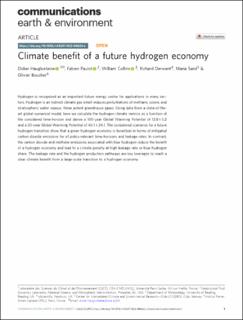| dc.contributor.author | Hauglustaine, Didier | |
| dc.contributor.author | Paulot, Fabien | |
| dc.contributor.author | Collins, William | |
| dc.contributor.author | Derwent, Richard | |
| dc.contributor.author | Sand, Maria | |
| dc.contributor.author | Boucher, Olivier | |
| dc.date.accessioned | 2024-02-19T14:30:50Z | |
| dc.date.available | 2024-02-19T14:30:50Z | |
| dc.date.created | 2022-12-13T11:28:42Z | |
| dc.date.issued | 2022 | |
| dc.identifier.citation | Communications Earth & Environment. 2022, 3 (1), . | en_US |
| dc.identifier.issn | 2662-4435 | |
| dc.identifier.uri | https://hdl.handle.net/11250/3118518 | |
| dc.description.abstract | Hydrogen is recognised as an important future energy vector for applications in many sectors. Hydrogen is an indirect climate gas which induces perturbations of methane, ozone, and stratospheric water vapour, three potent greenhouse gases. Using data from a state-of-the-art global numerical model, here we calculate the hydrogen climate metrics as a function of the considered time-horizon and derive a 100-year Global Warming Potential of 12.8 ± 5.2 and a 20-year Global Warming Potential of 40.1 ± 24.1. The considered scenarios for a future hydrogen transition show that a green hydrogen economy is beneficial in terms of mitigated carbon dioxide emissions for all policy-relevant time-horizons and leakage rates. In contrast, the carbon dioxide and methane emissions associated with blue hydrogen reduce the benefit of a hydrogen economy and lead to a climate penalty at high leakage rate or blue hydrogen share. The leakage rate and the hydrogen production pathways are key leverages to reach a clear climate benefit from a large-scale transition to a hydrogen economy. | en_US |
| dc.language.iso | eng | en_US |
| dc.publisher | Springer Nature ltd | en_US |
| dc.rights | Navngivelse 4.0 Internasjonal | * |
| dc.rights.uri | http://creativecommons.org/licenses/by/4.0/deed.no | * |
| dc.title | Climate benefit of a future hydrogen economy | en_US |
| dc.title.alternative | Climate benefit of a future hydrogen economy | en_US |
| dc.type | Peer reviewed | en_US |
| dc.type | Journal article | en_US |
| dc.description.version | publishedVersion | en_US |
| dc.source.pagenumber | 0 | en_US |
| dc.source.volume | 3 | en_US |
| dc.source.journal | Communications Earth & Environment | en_US |
| dc.source.issue | 1 | en_US |
| dc.identifier.doi | 10.1038/s43247-022-00626-z | |
| dc.identifier.cristin | 2092468 | |
| dc.relation.project | Norges forskningsråd: 320240 | en_US |
| cristin.ispublished | true | |
| cristin.fulltext | original | |
| cristin.qualitycode | 1 | |

